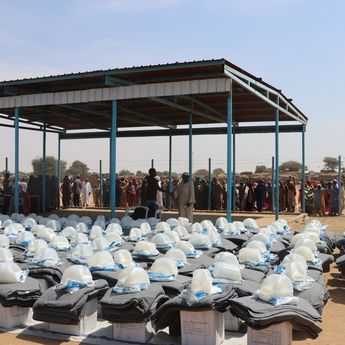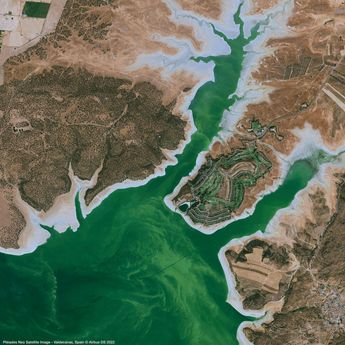The Airbus Foundation supports charitable initiatives worldwide, leveraging an international network of organisations, associations and Airbus employees. One of its core pillars of activity is humanitarian emergency response, as explained by Sophie Pignol, the Airbus Foundation’s Disaster Response & Operations Coordinator.
Q. What has the Airbus Foundation accomplished in its goal to support humanitarian response?
As of today, the Foundation has facilitated more than 28 relief and 58 goodwill flights to numerous destinations around the globe, transporting over 1,138 tonnes of aid. Airbus-owned flight test aircraft and customer aircraft (operated on delivery flights to the customers) have been used, along with the charter of Airbus-built aircraft. Recent examples are a charter flight to Madagascar after Cyclone Batsirai and an airlift to the Republic of Moldova related to the Ukraine crisis.
More than 1,250 helicopter flight hours have been performed involving a total of 44 operations in 24 countries for disaster rescue, evacuation and support missions, as well as for training.
The Airbus Foundation also provides satellite imagery to our partners on a regular basis, with 177 requests since 2017 to help in the assessment of major natural disasters and crises by the humanitarian sector worldwide.
I also want to mention that today is World Humanitarian Day. It is a day to honour all humanitarian workers who dedicate – and sometimes lose – their lives to provide life-saving support and protection to people most in need. I would like to thank the Foundation's partners for the incredible work that their teams do every day around the world. We are proud to support and collaborate with all of them in missions to help affected people in times of crisis.

Q. What organisations and agencies are supported by the Airbus Foundation today?
We work with some of the world’s top non-governmental organizations (NGOs) to provide humanitarian relief where needed, and the Airbus Foundation has become an established, respected and recognised partner in emergency response for the humanitarian community.
Today, partnerships have been established with: the International Federation of Red Cross and Red Crescent Societies (IFRC); the World Food Programme Global Logistics Cluster (WFP-GLC); the French government’s Centre de Crise et de Soutien (Crisis and Support Centre); the Kenyan Red Cross Society (KRCS), Action Contre la Faim (ACF), Médecins Sans Frontières (MSF), Fondation de l’Académie de Médecine (FAM), Aviation Sans Frontières (ASF) and the Spanish government’s Agency of International Cooperation for Development (AECID).
Q. How does the Airbus Foundation launch a humanitarian support mission?
The Foundation is not an emergency responder. Our role is to coordinate with the various stakeholders involved, and to provide support by providing access to Airbus products, services and people to help when our partners need us.
For missions where we provide airlift capacity, the Airbus flight test team is contacted to determine whether they have flight test aircraft available, and we have well-developed operating procedures to ensure missions are conducted safely and as rapidly as possible. We also can charter Airbus aircraft through an Airbus logistics provider when Airbus flight test aircraft are not available.
In the case of helicopter support, we look for Airbus operators who can respond to the missions’ needs. The coordination is performed via our Airbus Helicopters Customer Centre, which identifies operators who are well located to provide their support and have the appropriate rotorcraft to perform the mission.
Q. How long does it take for the Foundation to provide a humanitarian emergency response?
When requests are submitted by our NGO partners, the Foundation team replies as quickly as possible. Our humanitarian response team is always on call, even during weekends and holidays.
Preparing a humanitarian operation is complex, with multiple stakeholders involved. From receiving the initial NGO request, it usually takes a minimum of three days to gather the relevant information to make the initial go/no-go decision. No-go can be decided due to countries at risk or with limited access due to quarantine, embargo, export control restrictions, etc…
The timing depends on factors that include the partner’s preparedness, the request’s complexity, how many actors are involved, whether all the necessary information is provided and due diligence needed for any of the stakeholders involved. The Foundation maintains the highest standards of compliance and all work adheres to Airbus Ethics & Compliance directives and policies.
Another important aspect of the process is checking the availability of an Airbus test aircraft, an Airbus charter aircraft or helicopter, when support is requested. Following this, the planning, organisation and implementation of a solution is undertaken.
Q. Is Airbus Foundation able to adapt the type of support it provides the NGO partners?
Definitely! We’re always working to expand our portfolio of support to respond to our humanitarian partners’ needs. One example is the increasing amount of satellite imagery and related services that we supply, using information gathered by Airbus-built satellites – including the latest Pléiades high-resolution optical Earth-imaging constellation – to assess needs before our partners start their mission. In 2021, satellite imagery covering more than 43,000 square kilometres was delivered, with the Foundation responding to 93 requests to assist its partners in disaster relief, drought impact, medical activities, the displacement of persons, conflict resolution and poaching.
Another example is a pilot program that we are about to launch, using Airbus-operated ships which regularly transport large components of our aircraft within the Airbus industrial network. These vessels can be utilised to support our humanitarian partners by pre-positioning supplies to hub-type warehouses at Las Palmas in Spain and Panama.





